

Five Events That Will Shape Southeast Asia in 2015. As we prepare to leave 2014 behind, we explore five events that are expected to shape the coming year in Southeast Asia: Elections in Myanmar.
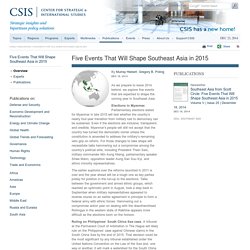
Parliamentary elections slated for Myanmar in late 2015 will test whether the country’s nearly four-year transition from military rule to democracy can be sustained. China and the U.S. Alliance System. Can China Build a Community of Common Destiny? Xi Jinping seems determined to build a “community of common destiny” in the Asia-Pacific.
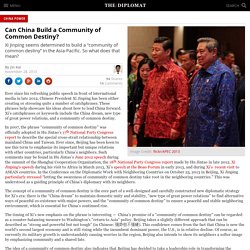
So what does that mean? Ever since his refreshing public speech in front of international media in late 2012, Chinese President Xi Jinping has been either creating or stressing quite a number of catchphrases. These phrases help showcase his ideas about how to lead China forward. Xi’s catchphrases or keywords include the China dream, new type of great power relations, and a community of common destiny. In 2007, the phrase “community of common destiny” was officially adopted in Hu Jintao’s 17th National Party Congress report to describe the special cross-strait relationship between mainland China and Taiwan.
Www.unescap.org/sites/default/files/Trade Insights - FTAAP - Issue No. 4.pdf. The TPP, China and the FTAAP: The Case for Convergence by Peter A. Petri, Michael G. Plummer, Fan Zhai. Peter A.

Petri Brandeis University - Brandeis International Business School; Brandeis University - Department of Economics; East-West Center Michael G. Plummer Johns Hopkins University Fan Zhai China Investment CorporationMay 19, 2014. TPP or FTAAP: What It Means for US and the Asia-Pacific RegionCHINA US Focus. Although not a household name like NAFTA, by now most Americans who follow trade issues have heard of the TPP (Trans-Pacific Partnership), the trade agreement under negotiation between the U.S., Japan, Canada, Mexico, Australia, New Zealand, Singapore, Vietnam, Malaysia, Peru, Chile and Brunei.
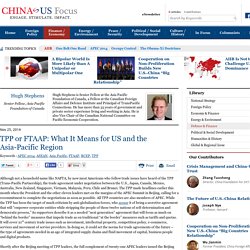
The TPP made headlines earlier this month when the President and the other eleven leaders met on the margins of the APEC Summit in Beijing, calling for a recommitment to complete the negotiations as soon as possible. All TPP countries are also members of APEC. Canada considers free trade with Thailand despite internal warnings. The Canadian government is exploring the idea of free trade with Thailand despite internal warnings from Foreign Affairs officials that Ottawa should hold back while the Asian country remains under control of a military junta, documents say.

A government memo dated Dec. 12, 2014 and marked “secret” that was obtained by The Globe and Mail shows public servants in Foreign Affairs cautioned the offices of Foreign Affairs Minister John Baird and International Trade Minister Ed Fast to pause this “exploratory process” with Thailand. The warning comes as the Conservative government has stressed “economic diplomacy,” asking its missions around the world to focus on promoting Canada’s commercial interests and trying to sign trade agreements where possible. In the meantime, department officials recommended in October that “any engagement on free trade agreement exploratory discussions only occur at the working level and on a responsive basis.” But Mr. This move is surprising given that Mr.
TPP or FTAAP: What It Means for US and the Asia-Pacific RegionCHINA US Focus. TPP or FTAAP: What It Means for US and the Asia-Pacific RegionCHINA US Focus. China-led RCEP talks to conclude in 2015. China’s Commerce Minister Gao Hucheng (L) speaks during the 17th ASEAN Economic Ministers(AEM) Plus Three Consultations at Myanmar International Convention Center in Nay Pyi Taw, Myanmar, Aug. 26, 2014 [Xinhua] The China-led RCEP trade negotiations will conclude by the end of next year, Economic Ministers from the 16 countries said on Thursday.
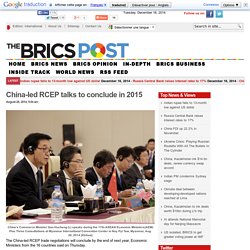
The RCEP, or Regional Comprehensive Economic Partnership, will be comprised of the 10-nation ASEAN club plus six others: China, India, Japan, South Korea, Australia and New Zealand. China flexes its muscles at APEC with the revival of FTAAP. Author: Mireya Solís, Brookings Institution The 2014 APEC leaders’ summit witnessed a string of successes in Chinese trade diplomacy.
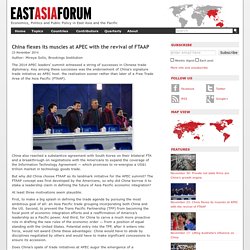
Comfortable Canada: But for how long? The last 25 years has been a relatively comfortable time for Canada.
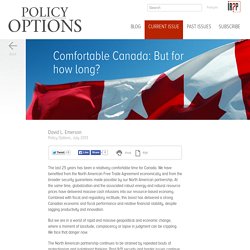
We have benefited from the North American Free Trade Agreement economically and from the broader security guarantees made possible by our North American partnership. At the same time, globalization and the associated robust energy and natural resource prices have delivered massive cash infusions into our resource-based economy. Combined with fiscal and regulatory rectitude, this boost has delivered a strong Canadian economic and fiscal performance and relative financial stability, despite lagging productivity and innovation. But we are in a world of rapid and massive geopolitical and economic change, where a moment of lassitude, complacency or lapse in judgment can be crippling. We face that danger now. The North American partnership continues to be strained by repeated bouts of protectionism and isolationist thinking. US-China Relations and the Geopolitics of the Trans Pacific Partnership Agreement (TPPA)
Engaging ASEAN: What Next for Canada? Introduction On 14 October 2013, Foreign Minister John Baird landed in Vientiane, Laos and made diplomatic and personal history.
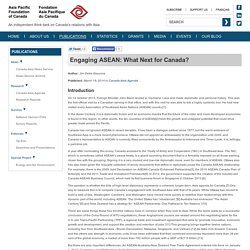
This was the first official visit by a Canadian serving in that office, and with this visit he was able to tick a highly symbolic box: He had now visited every Association of Southeast Asian Nations (ASEAN) country.[1]